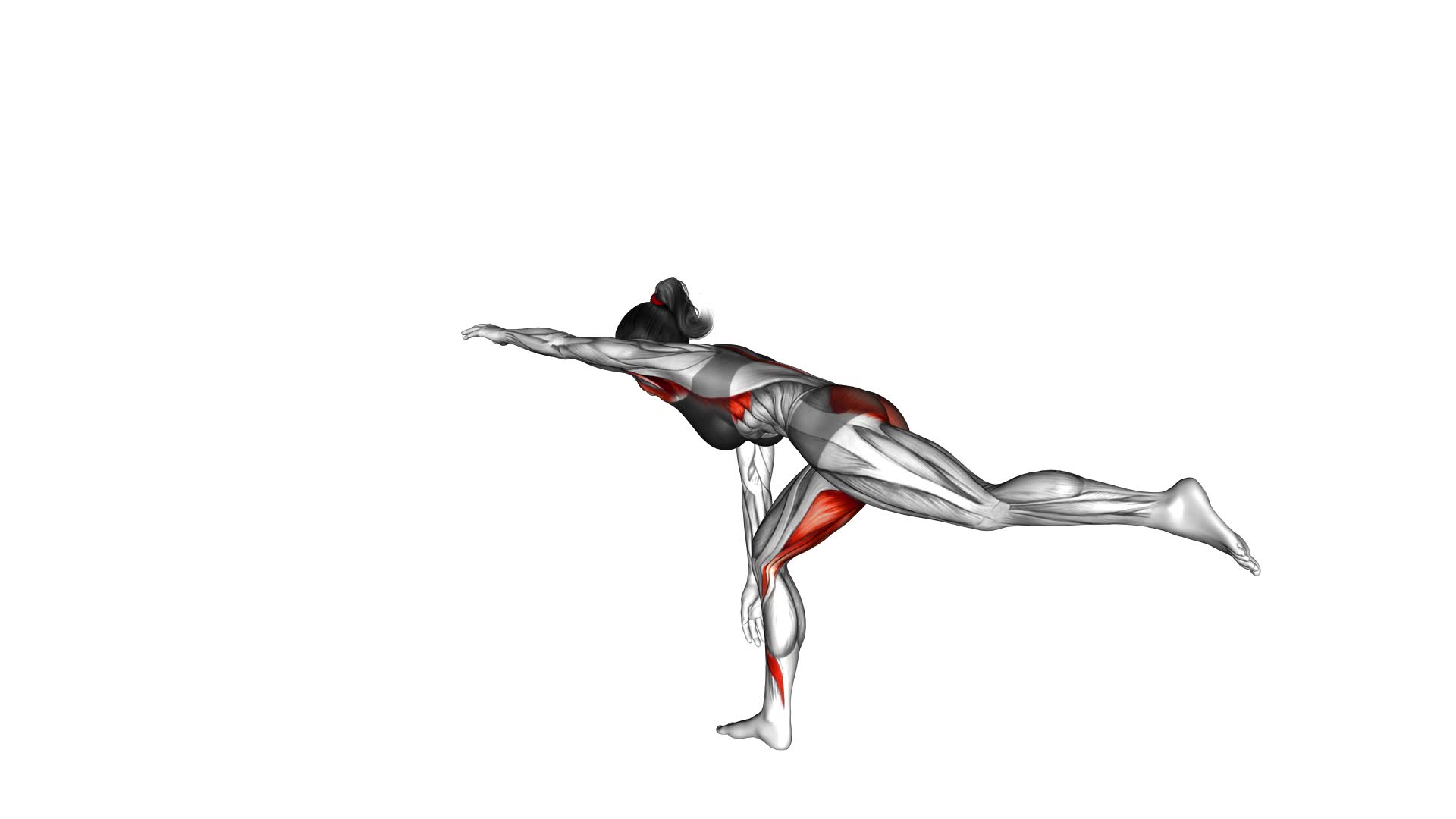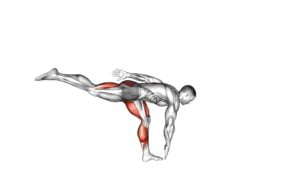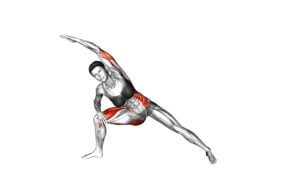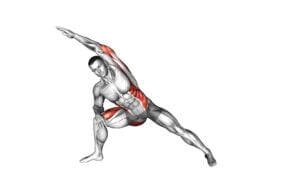Single Leg Bodyweight Deadlift With Arm and Leg Extended (Female) – Video Exercise Guide & Tips

Are you looking to strengthen your lower body and improve your balance?
Watch This Exercise Video
Then the Single Leg Bodyweight Deadlift with Arm and Leg Extended is the exercise for you!
In this video exercise guide, we'll show you the proper form and technique to perform this challenging move.
You'll also learn about progressions and modifications, as well as common mistakes to avoid.
Maximize your results with our helpful tips, and get ready to take your fitness to the next level!
Key Takeaways
- Strengthens core and improves balance
- Targets lower back, glutes, hamstrings, and calves
- Activates multiple muscle groups simultaneously
- Translates to improved overall strength and stability
Benefits of the Single Leg Bodyweight Deadlift
One major benefit of the Single Leg Bodyweight Deadlift is that it strengthens your core and improves balance. This exercise specifically targets the muscles in your lower back, glutes, hamstrings, and calves. By performing this movement on one leg, you engage your core muscles to stabilize your body and maintain balance throughout the exercise.
The Single Leg Bodyweight Deadlift also provides various workout variations to challenge your muscles in different ways. You can perform it with your arms extended overhead, holding a dumbbell or kettlebell, or even with a resistance band for added resistance. These variations allow you to target different muscle groups and increase the intensity of the exercise.
Furthermore, the Single Leg Bodyweight Deadlift activates multiple muscle groups simultaneously, making it an efficient and effective exercise. Not only does it work your lower body muscles, but it also engages your core muscles, including your abdominals, obliques, and lower back. This comprehensive muscle activation helps improve your overall functional strength and stability.
Incorporating the Single Leg Bodyweight Deadlift into your fitness routine can have numerous benefits. It not only strengthens your core and improves balance but also provides workout variations to keep your routine challenging and engaging. The muscle activation involved in this exercise translates to improved overall strength and stability, making it a valuable addition to any workout regimen.
Proper Form and Technique
To perform the single leg bodyweight deadlift with arm and leg extended properly, it's crucial to focus on core stability and alignment. By engaging your core muscles and maintaining a neutral spine, you can ensure proper form and prevent injuries.
Additionally, balance and coordination play a significant role in this exercise, as you need to maintain control throughout the movement. Practicing proper form and technique is essential for maximizing the benefits of this exercise and minimizing the risk of injury.
Core Stability and Alignment
Maintain proper core stability and alignment by engaging your abdominal muscles and maintaining a neutral spine throughout the single leg bodyweight deadlift exercise. Core activation is essential for maintaining balance and stability during this movement. Engaging your core muscles will help to stabilize your spine and prevent any excessive movement or rotation.
It's important to have body awareness during this exercise, paying attention to your alignment and making sure your body stays in a straight line from head to toe. Keep your shoulders back and down, and avoid overarching or rounding your back.
Balance and Coordination
To improve your balance and coordination during the single leg bodyweight deadlift, focus on maintaining a stable and controlled movement throughout the exercise. This will help you in improving proprioception, which is your body's ability to sense its position in space.
Start by standing tall with your feet hip-width apart and engage your core muscles. As you hinge forward at the hips, extend one leg behind you while simultaneously extending the opposite arm forward. Keep your back straight and your gaze fixed on a point in front of you to maintain proper alignment.
Balancing on one leg requires concentration and control, so take your time to master this movement and gradually increase the difficulty by adding weights or performing the exercise on an unstable surface.
Practicing this exercise regularly won't only enhance your balance and coordination but also strengthen your core and lower body muscles.
Injury Prevention and Safety
To ensure proper form and technique and prevent injuries, you should consistently focus on maintaining a stable and controlled movement throughout the single leg bodyweight deadlift exercise. Injury prevention is crucial in any exercise routine, and the single leg bodyweight deadlift is no exception.
One of the most important aspects of injury prevention is maintaining proper alignment. Keep your spine neutral and engage your core muscles to provide stability. Additionally, make sure to keep your weight evenly distributed between your standing foot and the foot that's lifted off the ground.
If you're new to this exercise or have any existing injuries or limitations, it's important to consult with a qualified fitness professional who can provide exercise modifications to suit your needs. Remember, safety should always be a priority during your workouts.
Progressions and Modifications
You can progress and modify the single leg bodyweight deadlift with arm and leg extended (female) exercise to challenge yourself further and tailor it to your fitness level. There are several progression options you can incorporate into this exercise to make it more challenging and effective.
One way to progress this exercise is by adding weights. You can hold dumbbells in each hand or use a barbell across your shoulders to increase the resistance. This won't only increase the difficulty of the exercise but also help to build strength in your lower body.
Another option for progression is to perform the exercise on an unstable surface. This could be a balance board, BOSU ball, or a foam pad. The instability will engage your core muscles even more and require greater stability and balance.
If you don't have access to weights or stability equipment, you can still modify the exercise by increasing the range of motion. Instead of just reaching down to touch your toes, try reaching for the ground or even extending your arm and leg further behind you. This will increase the challenge on your hamstrings and glutes.
Common Mistakes to Avoid
A common mistake to avoid when performing the single leg bodyweight deadlift with arm and leg extended (female) exercise is improper alignment of the standing leg. Proper alignment is crucial to ensure that you're targeting the correct muscles and minimizing the risk of injury.
Here are three common mistakes to avoid when it comes to proper alignment:
- Allowing the knee to collapse inward: This is a common mistake that can put unnecessary stress on the knee joint. Make sure to keep your knee in line with your toes throughout the movement. Imagine a straight line from your hip to your ankle and focus on keeping your knee in line with that line.
- Leaning too far forward or backward: Maintaining a neutral spine is essential for proper alignment. Avoid leaning too far forward or backward during the exercise as this can lead to strain in your lower back. Keep your spine aligned and engage your core to maintain stability.
- Not keeping the hips level: It's important to keep your hips level throughout the exercise. Avoid allowing one hip to drop lower than the other, as this can lead to imbalances and potential injuries. Engage your glutes and core to stabilize your hips and maintain proper alignment.
Tips for Maximizing Results
Maximize your results by incorporating these key strategies into your single leg bodyweight deadlift with arm and leg extended (female) exercise.
To maximize performance, it's important to focus on proper breathing techniques throughout the exercise. Proper breathing helps to stabilize your core, increase oxygen flow, and improve overall performance.
When performing the single leg bodyweight deadlift with arm and leg extended, make sure to inhale deeply through your nose as you lower your torso and extend your leg. This will help engage your core muscles and maintain stability. As you exhale through your mouth, focus on contracting your glutes and hamstrings to lift your body back up to the starting position.
Another tip for maximizing results is to maintain proper form throughout the exercise. Keep your back straight, shoulders pulled back, and core engaged. This will ensure that your muscles are properly activated and working efficiently.
Additionally, it's important to challenge yourself by gradually increasing the difficulty of the exercise. Start with a lighter weight or no weight at all and gradually add resistance as you become more comfortable and confident in your form and technique.
Sample Workout Routine
To create an effective workout routine, it's important to include exercises that target multiple muscle groups. This ensures that you're getting a well-rounded workout and maximizing your results.
Whether you're a beginner or more advanced, there are modifications available to accommodate varying fitness levels and help you progress at your own pace.
Let's explore some sample workout routines that incorporate these principles.
Effective Exercises for Beginners
Get started with effective exercises for beginners by incorporating simple, yet impactful movements into your workout routine. Building strength and improving fitness doesn't have to be complicated or overwhelming.
Here are three exercises to include in your beginner workout plan:
- Squats: This fundamental exercise targets your lower body, specifically your quadriceps, hamstrings, and glutes. Start with bodyweight squats and gradually increase the difficulty by adding weights or trying variations like sumo squats or jump squats.
- Push-ups: Push-ups are a great way to strengthen your chest, shoulders, and triceps. Modify the exercise by doing them on your knees or against a wall if needed. As you progress, aim to do full push-ups with proper form.
- Planks: Planks are an excellent core exercise that also engages your arms and legs. Start with a basic forearm plank and gradually increase the duration. Challenge yourself by trying side planks or plank variations like plank jacks.
Targeting Multiple Muscle Groups
Incorporating the exercises discussed in the previous subtopic into your workout routine will effectively target multiple muscle groups and help you build strength.
To further enhance your workout and maximize results, you can include a variety of sample exercises that target different areas of your body. For example, you can perform squats to target your lower body, push-ups for your upper body, and planks for your core muscles.
By including these exercises, you'll engage multiple muscle groups simultaneously, leading to a more efficient and effective workout.
Additionally, focusing on injury prevention is crucial when targeting multiple muscle groups. Make sure to warm up properly, use proper form and technique, and listen to your body to avoid overexertion and potential injuries.
Modifications for Varying Fitness Levels
For modifying the sample workout routine to accommodate different fitness levels, you can make adjustments based on your current abilities and goals. Here are some adaptations for different abilities and scaling options for various levels:
- Beginners: If you're new to exercise or have limited strength, start by performing the single leg bodyweight deadlift without extending your arm and leg. Focus on maintaining proper form and balance.
- Intermediate: As you progress, you can add light dumbbells or resistance bands to increase the intensity of the exercise. This will challenge your muscles and improve overall strength.
- Advanced: For those who are more advanced, you can incorporate a plyometric element by adding a jump at the top of the movement. This will enhance power and explosiveness in your lower body.
Frequently Asked Questions
How Many Calories Does a Single Leg Bodyweight Deadlift Burn?
When you perform single leg bodyweight deadlifts, you can burn a significant amount of calories. This exercise not only targets your glutes, hamstrings, and core, but it also increases your heart rate, resulting in calorie burn.
Can I Do the Single Leg Bodyweight Deadlift if I Have Knee or Hip Pain?
If you have knee or hip pain, it's important to listen to your body and avoid exercises that may aggravate your condition. The single leg bodyweight deadlift can put strain on the knees and hips, so it may not be the best choice for you.
Instead, consider alternative exercises that are gentle on these joints, such as glute bridges or seated leg lifts.
If you still want to incorporate a single leg exercise, you can modify the deadlift by using lighter weights or performing it with a shorter range of motion.
How Long Does It Take to See Results From Doing Single Leg Bodyweight Deadlifts?
To master single leg bodyweight deadlifts, it takes time and consistency. The benefits of this exercise are worth the effort, though.
By challenging your balance and stability, single leg deadlifts can improve your overall strength and coordination. Additionally, they target your glutes, hamstrings, and core muscles.
While everyone's progress may vary, you can start seeing results in a few weeks if you're consistent with your workouts and practice proper form.
Keep pushing yourself and you'll see improvement over time.
Can I Use Weights While Doing the Single Leg Bodyweight Deadlift for Added Resistance?
Yes, you can definitely use weights while doing the single leg bodyweight deadlift for added resistance. Incorporating weights can increase the intensity of the exercise and help build strength in your legs, glutes, and core.
This added resistance challenges your muscles and promotes muscle growth.
Additionally, incorporating balance exercises like the single leg bodyweight deadlift can improve your overall balance, stability, and coordination, enhancing your performance in other exercises and daily activities.
Are There Any Variations of the Single Leg Bodyweight Deadlift That Target Different Muscle Groups?
There are indeed different variations of the single leg bodyweight deadlift that target different muscle groups. By changing the position of your arms or adding weights, you can focus on different areas.
For example, holding weights in your hands while performing the exercise will increase resistance and target your glutes and hamstrings more intensely.
Alternatively, extending your arms overhead will engage your core muscles and improve balance.
These variations allow you to customize the exercise to target specific muscle groups.
Conclusion
In conclusion, the single leg bodyweight deadlift with arm and leg extended is a challenging exercise that offers numerous benefits.
It helps improve balance, stability, and overall strength, particularly in the lower body and core.
By following proper form and technique, progressing gradually, and avoiding common mistakes, you can maximize the effectiveness of this exercise.
Incorporating it into a well-rounded workout routine can contribute to your overall fitness goals.

Author
Years ago, the spark of my life’s passion ignited in my mind the moment I stepped into the local gym for the first time. The inaugural bead of perspiration, the initial endeavor, the very first surge of endorphins, and a sense of pride that washed over me post-workout marked the beginning of my deep-seated interest in strength sports, fitness, and sports nutrition. This very curiosity blossomed rapidly into a profound fascination, propelling me to earn a Master’s degree in Physical Education from the Academy of Physical Education in Krakow, followed by a Sports Manager diploma from the Jagiellonian University. My journey of growth led me to gain more specialized qualifications, such as being a certified personal trainer with a focus on sports dietetics, a lifeguard, and an instructor for wellness and corrective gymnastics. Theoretical knowledge paired seamlessly with practical experience, reinforcing my belief that the transformation of individuals under my guidance was also a reflection of my personal growth. This belief holds true even today. Each day, I strive to push the boundaries and explore new realms. These realms gently elevate me to greater heights. The unique combination of passion for my field and the continuous quest for growth fuels my drive to break new ground.







